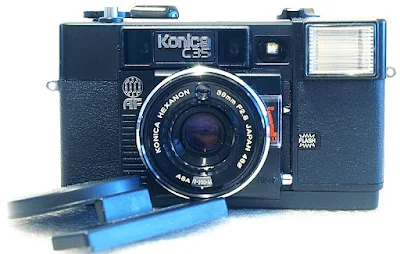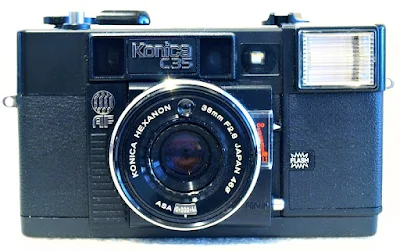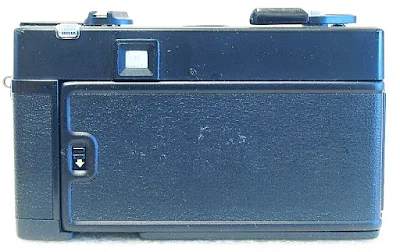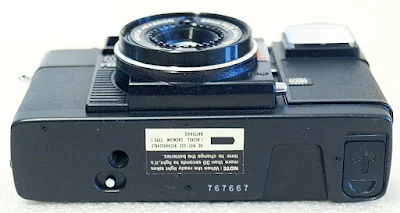The Konica C35 AF, a compact, fun, and easy-to-use 35mm point-and-shoot autofocus film camera, was the world's first production autofocus camera. The camera, nicknamed 'Jasupin' in Japan, was produced by Konica and launched as a follow-up to the very successful all-metal and glass Konica C35 series, which ended its production run with the Konica C35 FD/Auto S3.
Introduced in November 1977, the C35 AF is fitted with the 'Visitronic' AF system developed and produced by Honeywell, a 'passive' system as opposed to the 'active' version as used by Canon when they launched the AF35M a year and a half down the road. While most of the features of the camera are electronic, film advance and rewind are still mechanical.
Operationally, the C35 AF is fitted with a 4-element in 3-groups Hexanon 38mm F2.8 lens (similar to the rest of the series), a built-in electronic flash, and a behind-the-lens leaf shutter with speeds at 1/60, 1/25, and 1/250 second. The camera accepts film speeds from ISO 25 to 400, which is set by the ribbed rotating dial surrounding the front lens element. The lens takes 46mm screw-in filters.
コニカ C35AF(ジャスピンコニカ)の使い方 KONICA C35AF How to use 1970s world's first AF camera
コニカのレンズシャッター式オートフォーカスカメラ'C35AF'の基本的な使い方です。 How to use KONICA C35AF 1977 ブログ「集めるより使うクラシックカメラ」My blog: http://blog.livedoor.jp/rider1109/ rider1109のツイッター: http...
The automatic exposure control of the C35 AF is via a CdS AE system, with the autofocusing system coupled to the film wind and shutter release. The system will match the lens aperture opening to the appropriate shutter speed. The focusing range is from 1.1 meters to infinity, with the focusing distance indicated by the camera to the subject distance indicator after the shot is taken./p>
In its kit form, the Konica C35 AF comes with a case, shoulder strap, and a unique lens cover that caps the lens as well as the autofocus and viewfinder windows. The Konica C35 AF is said to have sold over a million units and was superseded in 1980 by a cosmetic update in the form of the C35 AF2.
Basic Camera Features
Common to the C35 series is, of course, the super-sharp 4-elements in 3-groups Hexanon 38mm F2.8 lens. The zone focusing system, as found on prior C35 manual focus cameras, has now been replaced on the C35 AF by a pointer dial to indicate the subject to focus distance.
A little bit Cubic, or with a tinge of the Bauhaus, the rectangular brickbat front of the C35 AF is further split into a couple of raised extrusions, the main one being the central lens mount housing. Central to the circular lens barrel is the front element of the lens itself, surrounded by a ribbed crown dial used for setting the film ISO speed. The CdS meter bubble is on the apex of the circle above it, and along the same flat surface on the lower part of the lens element, the film ISO speed display window, all within the outermost filter thread edge.
On the front of the top plane, above the lens mount platform, is a pair of fairly recessed autofocus triangulation windows, each on either side of the camera nameplate. Next to it, on the right, is the viewfinder window, and occupying the front right of the camera's front panel, the push-button release pop-up flash unit.
On the top panel, plain with no clutter at all, is the film rewind crank located slightly away from the left end of the top plane, as space is now allocated for the twin battery cells chamber. Right on the top edge, just aft and to the left of the film rewind lever, is the flash-ready pilot light.
On the right of the top panel are the shutter release button, film forward crank, and frame number display.
On the back, just the viewfinder eyepiece on the back of the top plane, and a plain hinged film back with a slide-down latch release.
On the bottom plane, the rewind release button, tripod socket, and battery chamber access.
The film box and transport mechanism are all mechanical and outfitted, as claimed by the manufacturer, with the 'simple and foolproof' Konica EL System.
Loading and Unloading Film
Loading and unloading the exposed roll of film, for the seasoned user, is easy and straightforward, but as always, something to be learned and practiced for the newbie photographer.
Viewfinder Readout
The viewfinder is a simple bright-frame unit with etched frame lines, parallax compensation, an autofocus spot, and an underexposure warning LED in the top right corner of the display.
Battery
The C35 AF requires the use of 2 x AA battery units to power all the requirements for the electronic flash, automatic exposure control, and focusing system. The use of alkaline units is recommended for the camera, as ordinary cells will run out after about 60 flashes.
Camera Body Weight
The Konica C35 AF camera's body weight is 375 grams without batteries.
A True Point-and-Shoot
I will have to admit that the Konica C35 AF is a true point-and-shoot camera. Beyond the film speed setting dial, shutter button, and winder lever, there is nothing more that you can control. When you can at least see the exposure meter needle of the original C35 rangefinder moving as you move the image frame around, and the rangefinder spot parallax converging as you adjust to varying focal distances, the C35 AF, besides just having an underexposure LED indicator, shows you nothing.
There is no half-press exposure regime, no AF lock utility, no low-light trickery, or backlight compensating at all. All you can do is square the autofocus spot in the viewfinder on the main subject in your image and release the shutter, and the camera takes over from there. The only feedback you can rely on is the camera-to-subject distance calibration that is displayed on the distance scale window after the shot is done.
A Dysfunctional Unit
I began to notice that the camera-to-subject distance scale on the camera I had just received through the mail was not moving at all, meaning that the autofocus system may be faulty or not functioning. The next best thing to do was to put the camera to the test with a fresh roll of film.
True enough, while the rest of the camera, including the flash, worked well, none of the images were in focus. My resolve, in the end, was that the camera was a dysfunctional unit, with a fault that is not commonly tested by those putting the camera on sale. This problem is unique to the specific brand model, which requires an extra pre-sale test procedure that not many are wary of or conscious about, something for the conscious buyer to look at.























Hi, It seems that the nickname Jasupin in Japanese means "in perfect focus", which unfortunately isn't true in your case. :-( I have just bought one of these cameras. From the serial number, it is around halfway through the production run as it is around 503,000 and they reckon that a million were sold between 1977 and 1980. Despite its age, it looks like it just came out of the factory and it has a pristine case with it too. I will need to replace the light seals, but that's an easy job. At first, I thought that the flash was kaput, but I then found that when I pressed on the battery cover, it started charging, so probably just a bad connection. The connectors are not corroded, but probably just oxidised with age. The autofocus on mine works perfectly, so there must have been enough power for that, or maybe the autofocus just uses one battery and the flash uses both. Anyway, I will have fun with it. Wouldn't let me sign in, even though I am signed in with Google, so this post will appear as "Anonymous". Best regards, Gordon in the UK.
ReplyDelete